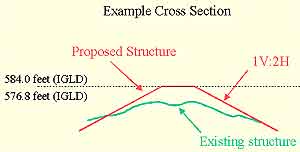|
||||
|
||||
|
Improvements
 Converting the breakwater from a segmented structure to a continuous structure would not prevent a significantly larger amount of shoreline erosion. In addition, such a structure would likely cause water stagnation between the structure and the shore, decreasing water quality. Taking no action does not solve the problem of the deteriorated breakwaters. The Milwaukee County Department of Public Works has earmarked money in the 2002 fiscal year budget for further South Shore breakwater rehabilitation planning including preliminary design and contract documents. An estimated budget for the entire project is just over $2 million. The overall process for implementing a project of this magnitude is understandably complex. The initial feasibility analysis of alternatives produces a viable alternative for preliminary design. Governing bodies often provide regulatory guidance even during this phase. The preliminary design then provides the basis for a final design. The final design is evaluated by the Wisconsin Department of Natural Resources for impacts on fisheries, water quality, navigation, aesthetics, shoreline protection, and various other public interests. The DNR then issues permits before construction may begin. |
